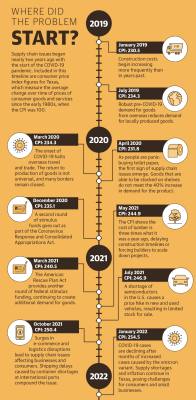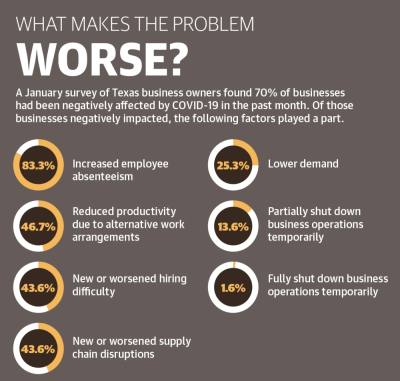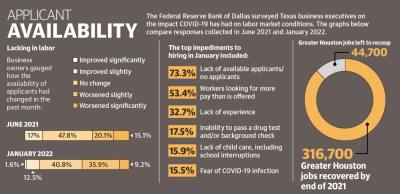Although the COVID-19 pandemic first debuted in Texas two years ago, survey data from the Federal Reserve Bank of Dallas revealed 70% of Texas business owners were negatively affected by the most recent COVID-19 surge in January.
“Many are starting to feel the pressures of inflation, but staffing seems to be where the biggest struggle is,” said Mark Linabury, president and CEO of the Greater East Montgomery County Chamber of Commerce. “Supply chain shortages are a real issue. I know of one [chamber] member that is ordering inventory years in advance, just in case.”
Businesses are facing higher operating costs and are starting to have to divert some of that burden onto customers, experts said. An inflation update from the Greater Houston Partnership reported a 7.9% rise in consumer prices nationwide as of February 2022 since the start of 2021.
Even so, there has been growth for the Lake Houston economy in the last year. According to Lance LaCour, president and CEO of Partnership Lake Houston, the number of businesses in the area increased from 8,144 in 2020 to 8,310 in 2021.
“We have seen a growth of [166] new businesses from 2020 to 2021,” LaCour said. “We’ve seen an annual growth rate of 1.97%, and consumer spending was $5.7 billion in 2021.”
Pandemic hardships
State-mandated shutdowns for nonessential businesses as well as mask requirements were staples of the early pandemic. In March 2021, however, Texas Gov. Greg Abbott lifted the mask mandate and allowed businesses to operate at 100% capacity.
Enduring the shutdown was difficult, said Steve Bixby, who owns the Bixby Properties and Green Oaks Tavern—a live music venue in Humble—with his wife, Debbie.
“We suffered badly,” Bixby said. “Many across the state in our situation were forced to close. [The state government] then offered the opportunity for bars to become restaurants. ... [So] we bought a hot dog roller.”
In 2022, businesses are still experiencing “aftershocks” of the pandemic, said Joe Breda, who owns Old Humble Distilling Co. in Atascocita.
“We’re behind by 12 months or more,” Breda said. “Because now you’ve got to catch up to where you were [before the pandemic] and then try to get to where you should be.”
Although Texas businesses have been operating at 100% capacity for about a year, owners are facing other pandemic-induced challenges.
Price increases have been rampant for certain items, according to the Bureau of Labor Statistics. The cost of meat, poultry, fish and eggs increased by 13% from February 2021 to February 2022, while the cost of motor fuel increased by 38.1%.
The price increases on food items have been the most challenging factor for Michael Swift, owner of J. Christopher’s Pizza-Pasta in Kingwood.
“We have seen prices skyrocket on certain items. A case of chicken used to cost $58; now it is $120,” Swift said. “We did a price increase of 8% over the last year, and we have had some pushback even though our price increase is not sufficient to cover our increased costs.”
Many of the issues businesses are facing are related to the supply chain—the flow of goods from the producer to the customer—which was essentially halted as nations ceased trading and shipping early on in the pandemic, according to Patrick Jankowski, senior vice president of research for the GHP. Although many ports have opened back up, variant outbreaks still pose a threat to this system.
Breda, who moved his whiskey distillery to Atascocita in 2020, said items experiencing the most shortages in his industry have been glass bottles and packaging materials.
Bixby, who serves a variety of beverages at his establishment, said he has seen prices jump in small spikes over time, especially for beer. Items that have been difficult for him to obtain include alcohol and straws.
“We went through about a two-month period where you couldn’t get a liter of Jack Daniels or Crown Royal,” Bixby said. “Right now, it’s very difficult to get scotch.”
Alongside supply chain disruptions are staffing shortages. The GHP reported there are around 92,300 fewer unemployed workers looking for work in the Houston region with unemployment down from 5.1% in December 2020 to 4.8% in December 2021.
Swift said he hopes customers will be patient with local businesses during this time, as they are often short-staffed or training new employees.
“With labor shortages, employee turnover, et cetera, the service might not be as fast, and that new employee might make a mistake,” he said. “If we slip, give us a break—we are all suffering together, and we will make it right.”
A rebounding economy
Although the pandemic has proved to be challenging and many local businesses across the U.S. closed permanently, the east Montgomery County area is seeing growth in 2022, Linabury said.
“Because we are experiencing tremendous growth here in east Montgomery County, business is actually good,” Linabury said. “In fact, during the pandemic, we experienced growth beyond projections.”
Likewise, LaCour said the Lake Houston area is continuing to thrive.
“Companies here are expanding, and new companies are locating here due to the outstanding assets, talent, amenities and quality of life we have to offer,” he said.
While staffing shortages and access to supply lines are unfavorable, Jankowski said he believes they are growing pains of an economy that has recovered. The GHP reported about 316,700 of the region’s 361,400 jobs lost have been recovered as of the end of 2021. The GHP also reported a 5.1% increase in job creation in 2021 with 151,800 new positions.
Breda said he believes one of the best things an individual can do to support local businesses is to get vaccinated.
“One of the worst things that could happen for me, as a small-business owner [is] I get sick, and I lose two weeks of productivity out of my shop,” he said.
Choosing to eat at a local restaurant as often as possible can make all the difference for a small business, Swift said.
“Pick the shop where you know the owner’s name and he or she is there every day and is possibly the one cooking your meal,” he said.
Mikah Boyd contributed to this report.








